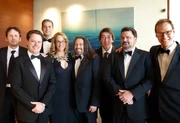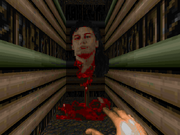
John Romero
Biography[]
Alfonso John Romero (born October 28, 1967,[1] in Colorado Springs, Colorado, United States) is a designer, programmer, and developer in the video game industry. He is best known as a co-founder of id Software and was a designer for many of their games, including Wolfenstein 3D, Dangerous Dave, Doom and Quake. His game designs and development tools, along with new programming techniques created and implemented by id Software's lead programmer John D. Carmack, led to a mass popularization of the first person shooter, or FPS, in the 1990s. He is credited with coining the FPS multiplayer term "deathmatch".[2]
Apple II[]
John Romero's first published game, Scout Search, appeared in the June 1984 issue of inCider magazine, a popular Apple II magazine during the 1980s. Romero's first company, Capitol Ideas Software, was listed as the developer for at least 12 of his earliest published games. Romero captured the December cover of the Apple II magazine Nibble for three years in a row starting in 1987. He won a programming contest in A+ magazine during its first year of publishing with his game Cavern Crusader.
Romero's first industry job was at Origin Systems in 1987 after programming games for 8 years. He worked on the Apple II to Commodore 64 port of 2400 A.D., which was eventually scrapped due to slow sales of the Apple II version. Romero then moved onto Space Rogue, a game by Paul Neurath. During this time, Romero was asked if he would be interested in joining Paul's soon-to-start company Blue Sky Productions, eventually renamed Looking Glass Technologies. Instead, Romero left Origin Systems to co-found a game company named Inside Out Software, where he ported Might & Magic II from the Apple II to the Commodore 64. He had almost finished the Commodore 64 to Apple II port of Tower Toppler, but Epyx unexpectedly cancelled all its ports industrywide due to their tremendous investment in the first round of games for the upcoming Atari Lynx.
During this short time, Romero did the artwork for the Apple IIGS version of Dark Castle, a port from the Macintosh. During this time, John and his friend Lane Roathe co-founded a company named Ideas from the Deep and wrote versions of a game named Zappa Roidz for the Apple II, PC and Apple IIGS. Their last collaboration was an Apple II disk operating system (InfoDOS) for Infocom's games Zork Zero, Arthur, Shogun and Journey.
id Software[]
Romero moved to Shreveport, Louisiana in March 1989 and joined Softdisk as a programmer in its Special Projects division. After several months of helping the PC monthly disk magazine Big Blue Disk, he officially moved into the department until he started a PC gaming division in July 1990 named 'Gamer's Edge' (originally titled PCRcade). Romero hired John Carmack into the department from his freelancing in Kansas City, moved Adrian Carmack into the division from Softdisk's art department, and persuaded Tom Hall to come in at night and help with game design. Romero and the others then left Softdisk in February 1991 to form id Software.[3]
Romero worked at id Software from its incorporation in 1991 until 1996. He was involved in the creation of several milestone games, including Commander Keen, Wolfenstein 3D, Doom, Doom II and Quake.[3] He served as executive producer (and game designer) on Heretic and Hexen. He designed most of the first episode of Doom, most of the levels in Quake, half the levels in the Commander Keen, Wolfenstein 3D and Spear of Destiny. He wrote many of the tools used at id Software to create their games, including DoomEd (level editor), QuakeEd (level editor), DM (for deathmatch launching), DWANGO client (to connect the game to DWANGO's servers), TED5 (level editor for the Commander Keen series, Wolfenstein 3D and Spear of Destiny), IGRAB (for grabbing assets and putting them in WAD files), the installers for all the games up to and including Quake, the SETUP program used to configure the games, and several others.
Ion Storm[]
- Main article: Daikatana
Romero later co-founded Ion Storm in Dallas, Texas with id co-worker Tom Hall, where he designed and produced Daikatana.[3] This ambitious shooter was announced in 1997 with a release date for the Christmas shopping season of that year. However, this release date slipped repeatedly in the coming months, and the game began to accrue negative press.
In particular, a 1997 advertisement boasting "John Romero's About To Make You His Bitch....Suck it down" caused controversy amongst gamers and the gaming press.[4] The massive pre-hype for the game and the subsequent delays (it was not released until April 2000) were compounded by the poor reviews the game received when it was finally complete.[5] Upon release, Daikatana was critically panned and appeared on numerous "top 10 worst games" listings.
During this time, Romero was rumored to have been killed (aptly enough, with a headshot) and a photograph of his corpse with a bullet wound was also spread through the Internet; Romero himself later stated that the picture was taken for the magazine Texas Monthly, and that "maybe he shouldn't have taken it".[6]
Romero departed with Tom Hall immediately after the release of Hall's Anachronox game and the subsequent closing of the Dallas Ion office.
Monkeystone Games[]
In July 2001, Romero and Hall founded Monkeystone Games in order to develop and publish games for mobile devices, and Monkeystone released 15 games (approximately) during its short lifespan of three and a half years. Some highlights of their developments included Hyperspace Delivery Boy! (Pocket PC, PC, Mac, Linux, GBA), Congo Cube (Pocket PC, PC, BREW, Java ME), and a version of Red Faction for the Nokia N-Gage. He and his girlfriend, Stevie Case, broke up in 2003, and she left the company in May while Red Faction development continued until October. John then left Monkeystone Games' day-to-day operations to Lucas Davis while Romero and Hall left for Midway in San Diego.[7]
Midway Games[]
In mid-October 2003, Romero joined Midway Games as project lead on Gauntlet: Seven Sorrows. While he continued to maintain his working relationship with Monkeystone, Lucas Davis took over running the office. The Monkeystone team moved to Austin, Texas to work on Midway's Area 51 title until its release. Monkeystone Games closed down in January 2005. Romero moved from project lead to creative director of internal studio during this time.
At the end of June 2005, Romero left Midway Games mere months before the completion of Gauntlet: Seven Sorrows.
Slipgate Ironworks[]
On August 31, 2005, Romero confirmed[8] that he has been working on a yet-to-be-announced MMOG at his newly opened development studio, Slipgate Ironworks. It has been reported that the name is temporary. "For the record," Romero wrote, "I'm co-founder of a new game company in the Bay Area and am much better off in many ways than I was at Midway". He said that he would not reveal anything about the company or the game until 2007. On March 17, 2009 it was announced that Slipgate Ironworks is part of Gazillion Entertainment.[9] According to Romero, he is a co-founder[10] of Gazillion.
On July 22, 2006, John Romero and former co-worker Tom Hall guest hosted episode 53 of the podcast The Widget.[11]
Romero departed Gazillion Entertainment in November 2010 to form a social game company called Loot Drop alongside Brenda Brathwaite.[12] His long time co-worker, Tom Hall joined the company on January 1, 2011.[13]
Cyberathlete Professional League[]
John Romero was the CPL's Chairman of the Board for ten years.
On December 20, 2006, John Romero announced a new FPS project for the Cyberathlete Professional League titled Severity for both consoles and PC.[14] It was announced that Tom Mustaine (ex-Studio Director at Ritual Entertainment) would act as Director of Game Development at CPL's new studio.
It is stated that Severity will be a multiplayer first person shooter. The game will be built on technology licensed from id Software.
In September 2008 Romero told ThatGamingSite that Severity was canceled, but Tom Mustaine contacted the site to inform them the project was not canceled but in "stealth mode" citing John Romero was "let out of the loop".[citation needed] On October 2009, Angel Munoz, founder of the Cyberathlete Professional League (CPL) stated that Severity was no longer being produced because they were not able "to convince game publishers of its value".[15]
Retro Gamer Collaboration[]
In March 2010, John Romero collaborated with the gaming magazine Retro Gamer and taking on the role of a guest editor, taking charge of the magazine's editorial and contributing to a number of articles and subjects throughout the magazine. There is an extensive interview with Romero in the issue with industry luminaries offering their thoughts on Romero.
Gamesauce[]
In Spring 2010, Gamesauce featured Romero on its cover and contained an in-depth interview with Romero written by Brenda Brathwaite.[16] In the interview, Romero publicly apologized for the infamous Daikatana advertisement.
Personal life[]

Romero and other game developers at a BAFTA event in Los Angeles in July 2011. From left: Rod Humble, Louis Castle, David Perry, Brenda Romero, John Romero, Will Wright, Tim Schafer, Chris Hecker.
Romero met his first wife, Kelly Mitchell, in 1987 while he worked at the register of a Burger King restaurant in Rocklin, California, and they had two children (Michael Alfonso and Steven Patrick Romero). He met his second wife, Elizabeth Ann McCall, in 1990 while she worked at Softdisk in Shreveport, Louisiana, and they had a daughter (Lillia Antoinette Romero). Romero was then involved with Stevie Case, a gamer who achieved early notoriety for beating him in a Quake deathmatch, from 1998 until their breakup in May 2003. In January 2004, Romero married Raluca Alexandra Pleşca in her hometown of Bucharest, Romania. The two later separated in early 2010.
Romero and game developer Brenda Brathwaite became engaged on March 24, 2012. They married on October 27, 2012.[17][18][19][20] Together, they worked on Ravenwood Fair, with Romero as Lead Designer and Brathwaite as Creative Director and Game Designer. They also founded social game development company Loot Drop in November 2010, and worked on Cloudforest Expedition and Ghost Recon Commander together.[12]
Doom II and Final Doom[]
In the Doom II final level "Icon of Sin", the final boss is supposed to be a giant demon head with a fragment missing from its forehead. It says, "To win the game, you must kill me, John Romero!", distorted and in reverse to sound like a demonic chant. One can use the idclip cheat to enter the boss and see Romero's severed head which is skewered on a post. The player defeats the boss (without the noclip cheat) by shooting rockets into its exposed brain after activating a lift and riding it; Romero's head functions as its hit detection point; when he "dies", the boss is killed and the game is finished.
The name "Romero" is written in blood on one of the walls in MAP19: Shipping/Respawning in Final Doom.
Levels by Romero[]

John Romero's head on a stick
Doom/The Ultimate Doom[]
- E1M1: Hangar
- E1M2: Nuclear Plant
- E1M3: Toxin Refinery
- E1M4: Command Control (with Tom Hall and Sandy Petersen)
- E1M5: Phobos Lab
- E1M6: Central Processing
- E1M7: Computer Station
- E1M8: Phobos Anomaly (with Sandy Petersen)
- E1M9: Military Base
- E4M2: Perfect Hatred
- E4M6: Against Thee Wickedly
Doom II[]
- MAP11: Circle of Death (a.k.a. 'O' of Destruction!)
- MAP15: Industrial Zone
- MAP17: Tenements
- MAP20: Gotcha!
- MAP26: The Abandoned Mines
- MAP29: The Living End
Doom add-on levels[]
Design rules[]
When designing levels for Doom, Romero came up with several rules, among them:
- always changing floor height when I wanted to change floor textures
- using special border textures between different wall segments and doorways
- being strict about texture alignment
- conscious use of contrast everywhere in a level between light and dark areas, cramped and open areas
- making sure that if a player could see outside that they should be able to somehow get there
- being strict about designing several secret areas on every level
- making my levels flow so the player will revisit areas several times so they will better understand the 3D space of the level
- creating easily recognizable landmarks in several places for easier navigation: http://web.archive.org/web/20111121052306/https://archive.gamespy.com/articles/december03/doom/romero/
Notes[]
John Romero is a character in Mike "Cyb" Watson's modification MassMouth 2.
- John Romero has shown interest in Doom The Way Id Did.
- John likes listening to heavy metal music. He supplied Bobby Prince a large number of heavy metal records, which was the inspiration for the MIDI rock music used in Doom 1 and Doom 2.
- Daikatana was referenced in three Doom WADs:
- In Action Doom, the first level contains an ad "Scuba Steve is a whiny little bitch" - a reference to the Daikatana ad.
- In the last level of Action Doom, a Daikatana box is on the table in the player's room.
- In MassMouth 2, Daikatana is given as a prize for saving Worm and killing Romero.
- In the sixth level of Action Doom 2: Urban Brawl, a secret item will be replaced by a Daikatana box if the player tries to reach the secret by noclipping. Picking it punishes the player and resets the points counter to zero.
- Daikatana itself also references Doom in the form of an in-game track. There's an area in the funeral home that plays a funereal rendition of the famous E1M1 "At Doom's Gate" track from Doom over an organ at a slower tempo.
References[]
- ↑ John Romero at the Internet Movie Database
- ↑ Template:Cite book
- ↑ 3.0 3.1 3.2 The Escapist - John Romero: The Escapist Interview. The Escapist.
- ↑ "The Top 7... PR Disasters" Game Radar
- ↑ "Romero Threatens to Make You His Bitch". Top 25 Dumbest Moments in Gaming History. June 2003. GameSpy.
- ↑ Dunkin, Alan. "Romero Speaks... From the Grave?" GameSpot. August 28, 1998.
- ↑ Retro Gamer magazine, issue 75: In the Chain with ... John Romero (pages 78-89)
- ↑ News - John Romero's new studio. September 21, 2005. Eurogamer.
- ↑ Gazillion in agreement with Marvel Entertainment to bring iconic super heroes to massively multiplayer games audience, unveils new company and studiosTemplate:Dead link March 17, 2009.
- ↑ John Romero's Twitterstream March 17, 2009.
- ↑ The Widget - Games, Tech, Whatever - Ep. 53 - Just Hanging Out
- ↑ 12.0 12.1 http://lootdrop.com/about/ Loot Drop's About page
- ↑ Template:Cite web
- ↑ Romero Announces New CPL Specific FPSTemplate:Dead link
- ↑ Angel Munoz Announces that Severity was cancelled
- ↑ Gamesauce Spring 2010. Spring 2010. Gamesauce.
- ↑ Brenda Romero's Facebook relationship status
- ↑ John Romero's Facebook relationship status
- ↑ Brenda Romero's tweet confirming their relationship status
- ↑ John Romero's Twitter status update confirming their relationship status

